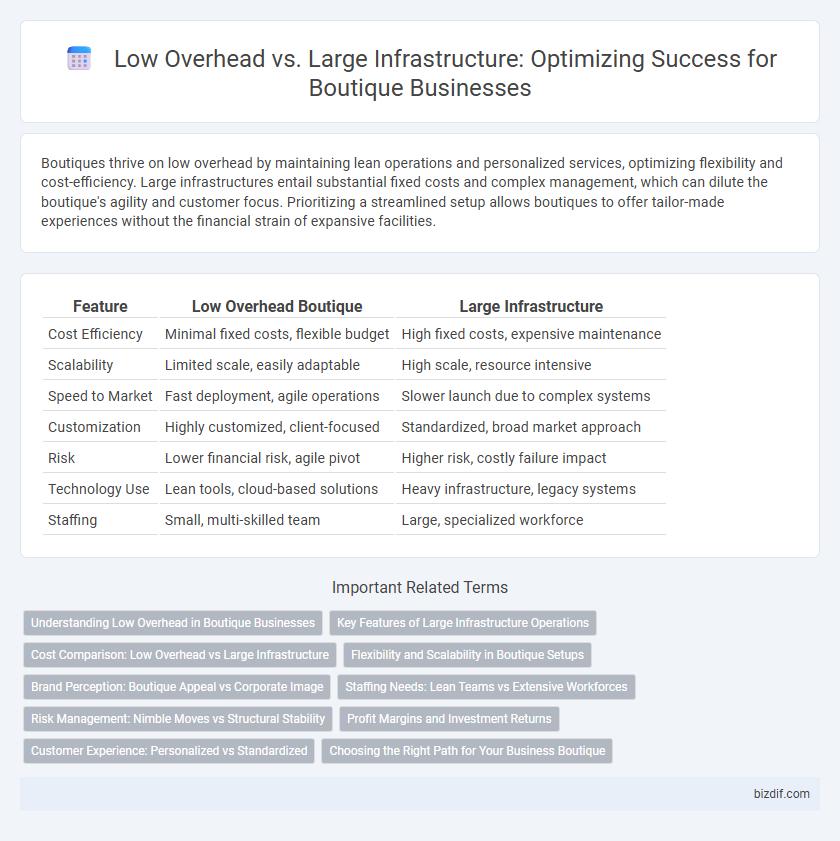Boutiques thrive on low overhead by maintaining lean operations and personalized services, optimizing flexibility and cost-efficiency. Large infrastructures entail substantial fixed costs and complex management, which can dilute the boutique's agility and customer focus. Prioritizing a streamlined setup allows boutiques to offer tailor-made experiences without the financial strain of expansive facilities.
Table of Comparison
| Feature | Low Overhead Boutique | Large Infrastructure |
|---|---|---|
| Cost Efficiency | Minimal fixed costs, flexible budget | High fixed costs, expensive maintenance |
| Scalability | Limited scale, easily adaptable | High scale, resource intensive |
| Speed to Market | Fast deployment, agile operations | Slower launch due to complex systems |
| Customization | Highly customized, client-focused | Standardized, broad market approach |
| Risk | Lower financial risk, agile pivot | Higher risk, costly failure impact |
| Technology Use | Lean tools, cloud-based solutions | Heavy infrastructure, legacy systems |
| Staffing | Small, multi-skilled team | Large, specialized workforce |
Understanding Low Overhead in Boutique Businesses
Low overhead in boutique businesses allows for greater flexibility and faster decision-making by minimizing fixed costs such as large office spaces or extensive staffing. This streamlined operational model enables boutiques to allocate resources efficiently, focusing on personalized services and niche markets. Reduced financial burden enhances adaptability, making it easier for boutique enterprises to respond swiftly to market changes and customer needs.
Key Features of Large Infrastructure Operations
Large infrastructure operations in boutique businesses emphasize scalability, robust supply chain management, and advanced technology integration to support high-volume production. Key features include extensive warehousing capabilities, automated inventory systems, and comprehensive quality control protocols to ensure consistency and efficiency. These operations often leverage centralized management and extensive workforce to optimize operational costs despite higher overhead.
Cost Comparison: Low Overhead vs Large Infrastructure
Low overhead in boutique businesses significantly reduces fixed costs by minimizing expenses related to large facilities and extensive staff, allowing for greater financial agility. Large infrastructure demands substantial investment in property, utilities, and maintenance, which increases operational costs and reduces profit margins. Cost comparison reveals that boutiques with low overhead achieve higher cost-efficiency and scalability by leveraging lean operations and targeted resource allocation.
Flexibility and Scalability in Boutique Setups
Boutique businesses benefit from low overhead costs by maintaining lean operations that enhance flexibility and allow rapid adaptation to market changes. Unlike large infrastructures, boutique setups can scale more efficiently with targeted resource allocation, avoiding the complexities and inefficiencies of extensive facilities. This agility supports personalized customer experiences and quicker innovation cycles, driving competitive advantage.
Brand Perception: Boutique Appeal vs Corporate Image
Boutique businesses often benefit from a low overhead model that fosters a personalized brand perception, emphasizing exclusivity and tailored customer experiences. In contrast, large infrastructure supports corporate brands that project stability and extensive resources but may risk appearing impersonal or generic. This distinction in operational scale directly influences how customers perceive authenticity and value in brand identity.
Staffing Needs: Lean Teams vs Extensive Workforces
Boutiques operate efficiently with lean teams, minimizing staffing costs while maximizing productivity through specialized roles. Large infrastructures demand extensive workforces to manage diverse operations, increasing payroll expenses and organizational complexity. Streamlined staffing in boutiques fosters agility and personalized service, contrasting the broad resource deployment typical of bigger enterprises.
Risk Management: Nimble Moves vs Structural Stability
Boutiques leverage low overhead to enable nimble moves, allowing swift adaptation to market changes and reduced financial risk during economic fluctuations. Large infrastructures offer structural stability through diversified resources and established processes, mitigating operational risks and ensuring consistent service delivery. Effective risk management balances the agility of low overhead with the resilience of extensive infrastructure to optimize business continuity and growth.
Profit Margins and Investment Returns
Boutique businesses typically maintain low overhead costs by operating with lean teams and minimal physical space, directly enhancing profit margins through reduced expenses. In contrast, large infrastructure demands substantial upfront investment and ongoing maintenance, which can dilute returns despite higher revenue potential. Optimizing investment returns in boutiques relies on agile management and targeted spending, enabling quicker scalability and sustained profitability.
Customer Experience: Personalized vs Standardized
Boutiques leverage low overhead to deliver highly personalized customer experiences, tailoring services and products to individual preferences, which fosters stronger client relationships and loyalty. Large infrastructure operations prioritize standardized processes to efficiently serve a broad customer base, often resulting in less customization but faster service. Personalized experiences in boutiques enhance customer satisfaction by addressing unique needs, whereas standardized approaches emphasize scalability and consistency.
Choosing the Right Path for Your Business Boutique
Opting for low overhead allows boutique businesses to maintain flexibility and reduce operational costs, fostering personalized customer experiences. In contrast, investing in large infrastructure supports scalability and broader market reach but demands significant capital and complex management. Evaluating your boutique's growth goals and financial capacity is crucial to selecting the optimal strategy for sustainable success.
Low Overhead vs Large Infrastructure Infographic

 bizdif.com
bizdif.com